Related Research Articles

A neutrino is a fermion that interacts only via the weak interaction and gravity. The neutrino is so named because it is electrically neutral and because its rest mass is so small (-ino) that it was long thought to be zero. The rest mass of the neutrino is much smaller than that of the other known elementary particles excluding massless particles. The weak force has a very short range, the gravitational interaction is extremely weak due to the very small mass of the neutrino, and neutrinos do not participate in the strong interaction. Thus, neutrinos typically pass through normal matter unimpeded and undetected.

Masatoshi Koshiba was a Japanese physicist and one of the founders of neutrino astronomy. His work with the neutrino detectors Kamiokande and Super-Kamiokande was instrumental in detecting solar neutrinos, providing experimental evidence for the solar neutrino problem.
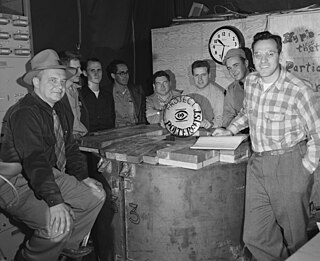
The Cowan–Reines neutrino experiment was conducted by physicists Clyde Cowan and Frederick Reines in 1956. The experiment confirmed the existence of neutrinos. Neutrinos, subatomic particles with no electric charge and very small mass, had been conjectured to be an essential particle in beta decay processes in the 1930s. With neither mass nor charge, such particles appeared to be impossible to detect. The experiment exploited a huge flux of electron antineutrinos emanating from a nearby nuclear reactor and a detector consisting of large tanks of water. Neutrino interactions with the protons of the water were observed, verifying the existence and basic properties of this particle for the first time.

A solar neutrino is a neutrino originating from nuclear fusion in the Sun's core, and is the most common type of neutrino passing through any source observed on Earth at any particular moment. Neutrinos are elementary particles with extremely small rest mass and a neutral electric charge. They only interact with matter via the weak interaction and gravity, making their detection very difficult. This has led to the now-resolved solar neutrino problem. Much is now known about solar neutrinos, but the research in this field is ongoing.

The IceCube Neutrino Observatory is a neutrino observatory constructed at the Amundsen–Scott South Pole Station in Antarctica. The project is a recognized CERN experiment (RE10). Its thousands of sensors are located under the Antarctic ice, distributed over a cubic kilometre.
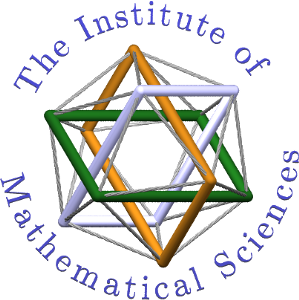
The Institute of Mathematical Sciences (IMSc) is a research centre located in Chennai, India. It is a constituent institute of the Homi Bhabha National Institute.

A neutrino detector is a physics apparatus which is designed to study neutrinos. Because neutrinos only weakly interact with other particles of matter, neutrino detectors must be very large to detect a significant number of neutrinos. Neutrino detectors are often built underground, to isolate the detector from cosmic rays and other background radiation. The field of neutrino astronomy is still very much in its infancy – the only confirmed extraterrestrial sources as of 2018 are the Sun and the supernova 1987A in the nearby Large Magellanic Cloud. Another likely source is the blazar TXS 0506+056 about 3.7 billion light years away. Neutrino observatories will "give astronomers fresh eyes with which to study the universe".

The Baksan Neutrino Observatory is a scientific laboratory of INR RAS located in the Baksan River gorge in the Caucasus mountains in Russia. Cleared for building in 1967, it started operations in 1977, becoming the first such neutrino observatory in the USSR. It consists of the Baksan Underground Scintillation Telescope (BUST), located 300 m (980 ft) below the surface, the gallium–germanium neutrino telescope located 4,700 m.w.e. deep as well as a number of ground facilities. The Baksan Experiment on Sterile Transitions (BEST) is currently (2019) being conducted at Baksan with aims of understanding sterile neutrinos.

SNOLAB is a Canadian underground science laboratory specializing in neutrino and dark matter physics. Located 2 km below the surface in Vale's Creighton nickel mine near Sudbury, Ontario, SNOLAB is an expansion of the existing facilities constructed for the original Sudbury Neutrino Observatory (SNO) solar neutrino experiment.
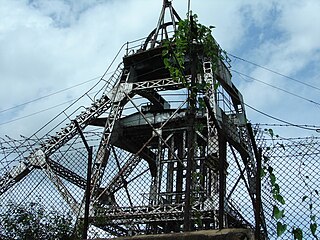
The Kolar Gold Fields (KGF), located in the Kolar district of the state of Karnataka, India, are a set of defunct gold mines known for the neutrino particle experiments and observations that took place there starting in 1960. The experiments ended with the closing of the mine in 1992.
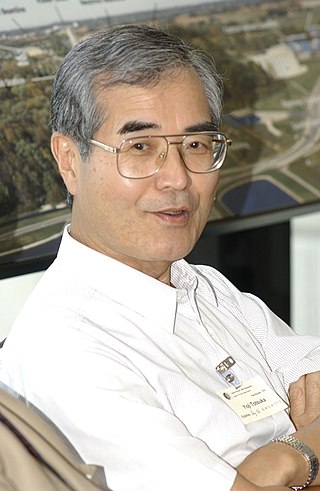
Yoji Totsuka was a Japanese physicist and Special University Professor, Emeritus, University of Tokyo. A leader in the study of solar and atmospheric neutrinos, he was a scientist and director at Kamioka Observatory, Super-Kamiokande and the High Energy Physics Laboratory (KEK) in Japan.
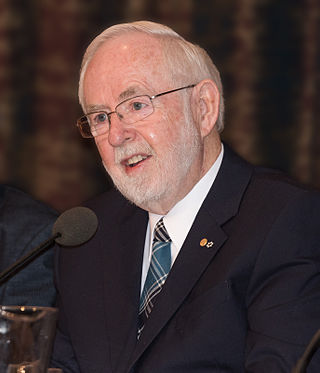
Arthur Bruce McDonald, P.Eng is a Canadian astrophysicist. McDonald is the director of the Sudbury Neutrino Observatory Collaboration and held the Gordon and Patricia Gray Chair in Particle Astrophysics at Queen's University in Kingston, Ontario from 2006 to 2013. He was awarded the 2015 Nobel Prize in Physics jointly with Japanese physicist Takaaki Kajita.

India-based Neutrino Observatory (INO) is a particle physics research project under construction to primarily study atmospheric neutrinos in a 1,200 meters (3,900 ft) deep cave under INO Peak near Theni, Tamil Nadu, India. This project is notable in that it is anticipated to provide a precise measurement of neutrino mixing parameters. The project is a multi-institute collaboration and one of the biggest experimental particle physics projects undertaken in India.
The solar neutrino problem concerned a large discrepancy between the flux of solar neutrinos as predicted from the Sun's luminosity and as measured directly. The discrepancy was first observed in the mid-1960s and was resolved around 2002.

Rohini Godbole is an Indian physicist and academic specializing in elementary particle physics: field theory and phenomenology. She is currently a professor at the Centre for High Energy Physics, Indian Institute of Science, Bangalore. She has worked extensively on different aspects of particle phenomenology over the past three decades, in particular on exploring different aspects of the Standard Model of Particle Physics (SM) and the physics beyond it (BSM). Her work regarding hadronic structure of high-energy photons outlined a variety of ways in which to study it and has had implications for the design of next generation electron positron colliders. She is an elected fellow of all the three academies of Science of India and also the Science Academy of the Developing World (TWAS).

Sekhar Basu was an Indian nuclear scientist who served as the chairman of the Atomic Energy Commission and Secretary to the Government of India, Department of Atomic Energy (DAE). He also served as the Director of Bhabha Atomic Research Centre (BARC), the Project Director of Nuclear Submarine Program, and later as the Chief Executive of the Nuclear Recycle Board at Bhabha Atomic Research Center. He was a recipient of India's fourth highest civilian honor Padma Shri in 2014.
Herbert Hwa-sen Chen was a theoretical and experimental physicist at the University of California at Irvine known for his contributions in the field of neutrino detection. Chen's work on observations of elastic neutrino-electron scattering provided important experimental support for the electroweak theory of the standard model of particle physics. In 1984 Chen realized that the deuterium of heavy water could be used as a detector that would distinguish the flavors of solar neutrinos. This idea led Chen to develop plans for the Sudbury Neutrino Observatory that would eventually make fundamental measurements demonstrating that neutrinos were particles with mass.
Probir Roy is an Indian particle physicist and a former professor at Tata Institute of Fundamental Research. He is also a senior scientist of the Indian National Science Academy at Bose Institute and a former Raja Ramanna fellow of Department of Atomic Energy at Saha Institute of Nuclear Physics.
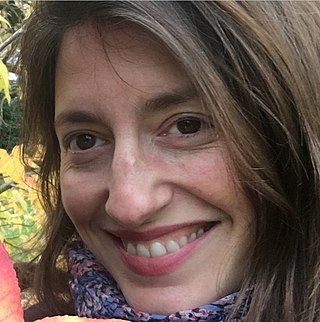
Jocelyn Monroe is an American experimental particle physicist who is a professor at Royal Holloway, University of London. Her research considers the development of novel detectors as part of the search for dark matter. In 2016 she was honoured with the Breakthrough Prize in Fundamental Physics for her work on the Sudbury Neutrino Observatory.
Supernova neutrinos are weakly interactive elementary particles produced during a core-collapse supernova explosion. A massive star collapses at the end of its life, emitting on the order of 1058 neutrinos and antineutrinos in all lepton flavors. The luminosity of different neutrino and antineutrino species are roughly the same. They carry away about 99% of the gravitational energy of the dying star as a burst lasting tens of seconds. The typical supernova neutrino energies are 10 to 20 MeV. Supernovae are considered the strongest and most frequent source of cosmic neutrinos in the MeV energy range.
References
- 1 2 "Theoretical Physics - Faculty". imsc.res.in. Retrieved 2020-07-20.
- 1 2 3 4 5 6 7 "Indu Likes Her Neutrinos Muon-Flavoured". The Life of Science. 2016-09-19. Retrieved 2020-07-20.
- 1 2 3 Freidog, Nandita Jayaraj, Aashima (27 August 2019). "Meet the Indian scientist who wants to capture one of the universe's smallest particles". Quartz India. Retrieved 2020-07-20.
{{cite web}}: CS1 maint: multiple names: authors list (link) - 1 2 3 4 5 6 7 "Department of Physics | Indian Institute Of Technology Madras, Chennai". physics.iitm.ac.in. Retrieved 2020-07-20.
- ↑ DASS, N. D. HARI; INDUMATHI, D.; JOSHIPURA, A. S.; MURTHY, M. V. N. (1987). "ON THE NEUTRINOS FROM SN 1987a". Current Science. 56 (12): 575–580. ISSN 0011-3891. JSTOR 24091285.
- ↑ "Indumathi Duraisamy - Google Scholar". scholar.google.co.in. Retrieved 2020-07-20.
- ↑ "INSPIRE". inspirehep.net. Retrieved 2020-07-20.
- ↑ "TEDxNapierBridgeWomen | TED". ted.com. Retrieved 2020-07-20.
- ↑ Staff Reporter (2012-10-19). "Neutrino project work not a threat to Mullaperiyar dam". The Hindu. ISSN 0971-751X . Retrieved 2020-07-20.
- ↑ Staff Reporter (2015-01-23). "INO will open research activities to rural students". The Hindu. ISSN 0971-751X . Retrieved 2020-07-20.
- ↑ "Why India's Most Sophisticated Science Experiment Languishes Between a Rock and a Hard Place". The Wire. Retrieved 2020-07-20.
- ↑ "Green nod to nuclear research project suspended by NGT". outlookindia.com/. Retrieved 2020-07-20.
- ↑ Rummler, Troy. "Bringing neutrino research back to India". symmetry magazine. Retrieved 2020-07-20.
- ↑ Indumathi, D.; INO Collaboration (2004-12-01). "India-based Neutrino Observatory (INO)". Pramana. 63 (6): 1283–1293. Bibcode:2004Prama..63.1283I. doi:10.1007/BF02704895. ISSN 0973-7111. S2CID 73599707.
- ↑ Indumathi, D. (2015-07-15). "India-based neutrino observatory (INO): Physics reach and status report". AIP Conference Proceedings. 1666 (1): 100003. Bibcode:2015AIPC.1666j0003I. doi: 10.1063/1.4915571 . ISSN 0094-243X. OSTI 22490649. S2CID 122819198.